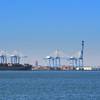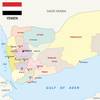The latest catamaran to pierce the waves from Incat Tasmania is Milenium, which was delivered to Transmediterranea for operation in the Mediterranean. Launched this past April from Incat's Coverdales shipbuilding facility at Hobart's Prince of Wales Bay, the 315 ft. (96 m) vessel entered service this past May.
Milenium offers a total of 330 truck lane meters at 3.1 x 4.3 m clear height, making it suitable for heavy road transport vehicles, and 370 car lane meters at 2.3 x 2.1 m.
The vessel's control station is equipped with the most innovative electronic, navigation and communication equipment to comply with High Speed Craft Code Sea Area 2, and an aft-facing docking console and television monitors cancel out the necessity for bridge wings with their associated structural weight and windage.
Powered by four Ruston 20RK270 marine diesel engines developing in excess of 28,000 kW, the vessel's 20-cylinder engines drive transom-mounted steerable Lips 150D waterjets via Reintjes gearboxes. All four of Milenium's waterjets are designed for steering and reversing, while an independent hydraulic system in each hull controls the steering and reverse functions.
In a joint effort with Maritime Dynamics, Incat has developed a fully integrated Ride Control System, which is comprised of transom mounted trim tabs and a new retractable T-Foil located at the aft end of the centerbow.
Mayflower Lines Is Newest U.S.-Flagged Operation
Based in Fort Lauderdale, Fla., Mayflower Ocean Lines is laying out the blueprints for the design, construction, and operation of a 75,000-ton, 2,000 passenger U.S.-Registered passenger ship.
The South Florida cruise line is following the recent trend of U.S.-built, flagged and crewed passenger ships.
While the inaugural company is focused on catering to the modern vacationer, with a large, custom-built vessel, the line will not market the vessel exclusively within this realm. The company has an additional mission to operate the ship in an untapped niche market, specifically for business meetings, conventions and incentive travel programs onboard U.S.-Flag cruise ships sailing on U.S.-ports-only destinations. Named Mayflower II, the projected vessel will become a venue-at-sea for the $110+ billion per year business meetings industry. Subsequent to extensive research by the line, the vessel will offer several meeting rooms, conference center, exhibit space and approximately 32,000 sq. ft. of meeting space in addition to public lounges, business centers and dining facilities.
Operating through a strategic partnership with a major hotel corporation, the passenger vessel, will operate seven-day cruises through ports in the American Caribbean from its homeport in South Florida.
The ship's meeting facilities will be comparable to that of land-based offerings, and will offer such features as live video-conferencing, satellite-based Internet access and audio-visual equipment. Mayflower II's wireless and satellite-based technology will be provided through a partnership with a Silicon Valley communications firm.
Still in the preliminary design stages, Mayflower Ocean Lines expects to negotiate a ship-construction contract with a U.S.-based shipyard to ensure that the vessel is in compliance with all specifications, configurations and design outlines required for its service. The company aims to work closely with the U.S. Maritime Administration (MarAd), as it plans to apply for the Federal Ship Finance Program (Title XI), which will provide for a credit guarantee by the U.S. Government of debt obligations for up to 87.5 percent of the cost of ship construction.
Machinery onboard Mayflower II will be comprised of gas-turbine engines with an Azipod propulsion system, allowing for greater maneuverability while reducing overall space requirements. Measuring 870 ft. (265 m) with a draft of 26 ft. (7.9 m), the vessel will cruise at a speed of 22 knots.
From a design standpoint, Mayflower II will focus on America's maritime heritage and history by featuring museum-like displays, such as artifacts and charts from the original Mayflower era through the last of the high style Trans-Atlantic liners. Overseeing the Mayflower Lines project is Robert Chamberlin — an 18-year veteran of the maritime and cruise industries. Chamberlin, who will serve as president/CEO on the project, has played an active role in the cruise industry in both South Florida and the Pacific Northwest.
WaveMaster Lands Ten Ferry Order
WaveMaster International has won a contract for ten 118 ft. (36 m) high-speed aluminum monohull ferries for delivery to Singapore. With firm contracts for the initial six vessel order already placed, financing has been arranged through Singapore-based Caterpillar Credit Services Asia, a subsidiary of Caterpillar Financial Services. Both the shipyard and purchaser have signed options for the remaining four vessels.
The WaveMaster design team developed this 118 ft. (36 m) monohull directly in sync with stringent safety requirements of the High Speed Craft Code, as set out by the International Maritime Organization (IMO) and Singapore Marine Authorities. Estimated design and build time is nine months for the initial six vessel order. Hulls and superstructures will be built in separate halls to speed up construction, although the real key to speed of production is WaveMaster's 3-D Unigraphics design solution.
This innovation, which is used traditionally in the production of motor vehicles and aircraft — produces a solid model of the vessel — allowing customers to gain a realistic insight of WaveMaster's design. This ensures that everyone involved fully understands the design before construction — helping to avoid costly reworks. Expected to revolutionize fast ferry travel between Singapore and Indonesia's Rau Islands, the 10-vessel fleet is scheduled for delivery in early 2001.
MAN B&W Diesel Selected By TOTE
Totem Ocean Trailer Express (TOTE), Tacoma, Wash., has chosen MAN B&W four-stroke engines for their new RoRo vessels. Each vessel's diesel electric propulsion plant will be outfitted with six MAN B&W Diesel engines comprised of four MAN B&W 9L58/64 engines of 11,700 kW each, and two 9L27/38 engines with 2,700 kW each, for a total output of 52,200 kW.
The vessels, which are scheduled for delivery in 2002, will be constructed at NASSCO in San Diego, Calif. for operation between Alaska and Washington. The vessels' resiliently-mounted engines are designed to withstand extreme roll requirements as part of their regular operating scenario.
MAN B&W's latest innovation, the 27/38 series engine, will be implemented for power generation on board. The 27/38 series covers output ranges between 1,500 kW and 3,060 kW, and is part of a new breed of medium-speed engines from MAN B&W, which provides easy installation and maintenance, as well as economic operation.
Featured videos

Tracking Foreign Vessels Working in the U.S. Jones Act Market

Inside the Electrified Truckable Tug

Inmarsat Enhances Service to Drive Digitalization
Subscribe for
Maritime Reporter E-News
Maritime Reporter E-News is the maritime industry's largest circulation and most authoritative ENews Service, delivered to your Email five times per week









